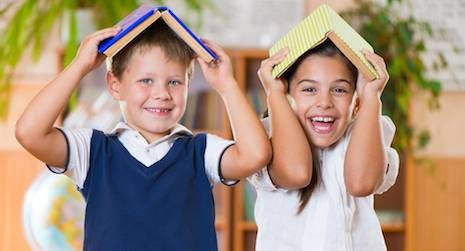
The Evolution of My Classroom Library
I have been a public school teacher for almost ten years, and the entire time, reading aloud has been my absolute favorite part of the job. I remember a moment in front of my first class on the first day of school– I had my professors’ letters of recommendation taped over my desk, my classroom all shined up and ready to go, but when I looked at the group of twenty 6-yr-olds staring up at me, I was hit by a wave of horror. I was in charge. All my lesson plans flew out of my head. I honestly could not remember what I was supposed to do. With shaking hands, I picked up the nearest picture book, held it up next to my shoulder, and started to read. My heartbeat calmed. My shaking subsided. I regained my control. In all the years that have followed, I’ve yet to encounter a classroom issue that cannot be solved by stopping everything and indulging in a good story.
Even though my adoration of books is still going strong, one thing that has changed a lot is my classroom library. While curriculum products and workbooks are typically standard across grade levels and school districts, the library that a teacher keeps in their classroom varies widely, and it almost always paid for out of pocket. Let me share with you the evolution of a classroom library.
When you start out, you’re usually furnishing your classroom before your first paycheck (and even when they start rolling in, they’re not that impressive). Finding books for your students is not so much about what would be a great fit as it is finding ANYTHING to get your hands on. Yard sales? Check. Giveaways from veteran teachers culling their collections? Check. Whatever you can find in your childhood basement? Check. Public library rejects? Check. While it’s wonderful to have these avenues, what’s lost in the bargain is choice. If you’re desperate for early reader chapter books, you’re not going to be able to turn down a series you’re not a fan of because of historical inaccuracies (*cough* MAGIC TREE HOUSE *cough*). If you know that your students would get a huge kick out of Elephant and Piggie but all you have is a class set of Dr. Seuss books, you’re stuck with the Dr. Seuss books. You’re limited to what others are giving away, and forced to make decisions about quantity over quality.
If you make it past the rookie years, you start accumulating better choices. Book orders and book fairs, gifts from parents or friends, quality literature you pick up a few titles at a time– slowly you start building a collection you can be proud of. But there’s another hurdle in the path of public school teachers, and that is resistance to change. Maybe it’s the fact that we have to live off the hand-me-downs of other teachers, but while expectations and testing situations change chaotically, our classroom set ups and materials often remain the same. FOR DECADES. For example: the book display. Many elementary teachers change out displays of books according to the seasons. As long as I’ve had a classroom, I’ve followed these rhythms. Back to school in September, Thanksgiving in November, February is hearts, March is leprechauns, so on and so on. Every year, the rotation happens without thinking. Except recently I started thinking.
It began last November, when I started learning a lot more about the seriously harmful narratives that are perpetuated around Native Americans and the Thanksgiving story. I thought a lot about how I talk about the holiday with my students, and realized that my discussions usually focused on thankfulness. But then I thought about the books I put out, and realized that a GOOD DEAL of them had harmful and incorrect stereotypes. Some of them were hand me downs, but plenty were included because of my own thoughtlessness. I spent some time reading Debbie Reece’s blog, American Indians in Children’s Literature, and started making some changes.
This got the ball rolling. In December, I started researching winter holidays around the world, trying to grow my collection to include more representation of different traditions. As I read these stories with my students, there were more questions than moments of recognition, but I reminded myself that normalizing possibly unfamiliar celebrations is a gift I can give the children who move through my classroom. In February, I began adding picture books that celebrate famous Black Americans in celebration of Black History Month. This March, I skipped the leprechauns all together and put together a display for Women’s History Month. Being thoughtful about what I want my students to get out of their reading experience, as opposed to just searching out books my students enjoy or fit the season, is a major step in the evolution of my collection.
My classroom library still has a long way to go until I have a collection that completely meets the needs of all my students. I’m constantly discovering new titles that teach phonics using comics or have princesses bucking traditional roles. Finding really good children’s literature that avoids stereotypes and normalizes the entire spectrum of humanity is a lot of work. But changing trends in publishing and the continual call from teachers and librarians for titles that help us meet those goals are getting us closer to the dream of having a library that expands the minds of our students. It all starts in school.











